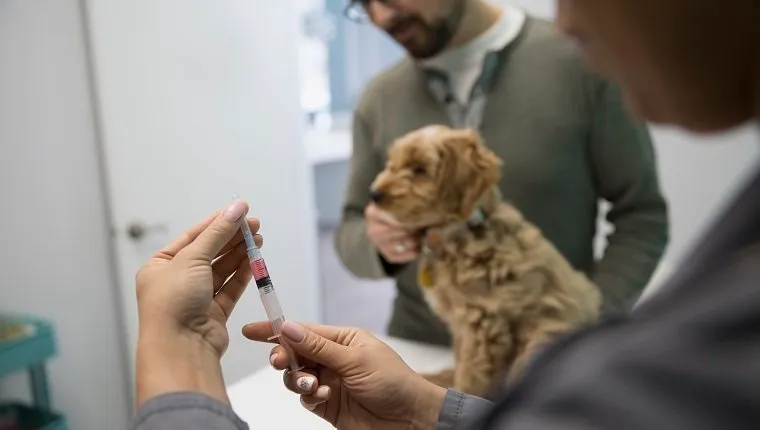Anaphylaxis in dogs is a severe allergic reaction that can result in anaphylactic shock, respiratory or cardiac failure, or even death. The reaction can be localized to a certain part of the body or be more general and involve the shut down of major organs.
Because almost any substance can cause an allergic reaction in dogs, anaphylaxis can be unpredictable. However, anaphylactic reactions are often triggered by a known allergen that a dog has come into contact with before.
If you spot the symptoms of anaphylaxis in your dog, you must seek emergency veterinary attention right away. The condition can be deadly, but most dogs who receive medication in time make a full recovery.
Here’s what you should know about anaphylaxis in dogs.
Symptoms Of Anaphylaxis In Dogs

The first organ to be affected by anaphylactic shock in dogs is usually the liver, which causes extreme upset to the digestive system. Unlike humans, dogs may not exhibit signs of swelling in the face or throat in some cases.
Here are symptoms of a severe allergic reaction that you should look out for in your dog and immediately seek medical attention if you spot them:
- Vomiting
- Diarrhea
- Pale gums
- Cold limbs
- Excessive salivating or drooling
- Wheezing and difficulty breathing
- Increased heart rate or a weak pulse
- Seizures
- Shock
- Coma
Some cases of anaphylaxis are less extreme and more localized. Though these symptoms are less severe, they still require veterinary care and can develop into anaphylactic shock with repeated exposure to the allergen.
Here are a few less intense signs of allergic reaction that you should look out for:
- Skin problems like hives, swelling, bumps, rashes, or itchy areas
- Congestion
- A dry, chronic cough
- Difficulty breathing during exercise
- Vomiting after eating certain foods
Causes Of Anaphylaxis In Dogs

Nearly any foreign substance introduced to the body can cause an anaphylactic reaction in dogs.
The most common allergens that cause anaphylaxis in dogs are the same as those that cause anaphylaxis in humans. These include:
- Insect bites and stings
- Food or chemicals used to prepare food
- Injections of medication or vaccines
- Other types of medication
Treatments For Anaphylaxis In Dogs

Because any foreign substance can potentially cause an anaphylactic reaction in dogs, it is difficult to prevent an initial occurrence; however, once an allergen is identified, it’s important to avoid repeated exposure.
Even allergens that cause minor reactions initially can lead to anaphylaxis over time if a dog is exposed again.
Treatment is medical emergency. If your dog is suffering from anaphylaxis, the first thing a veterinarian will do is remove the allergen if it is still present — for example, a bee’s stinger.
Your vet will then work to stabilize your dog. In some cases, a vet may inject adrenaline and give the dog antihistamines and hydrocortisone to get the reaction under control.
Your dog may also need oxygen and intravenous fluid to avoid a drop in blood pressure. Once your dog is stabilized, they will have to be strictly monitored for a day or two.
If your dog has ever had an allergic reaction to a vaccine or injection, this information must go into your dog’s medical file, and you must inform your vet of these past reactions. Your vet will likely change the type of medication or exclude certain vaccinations.
For food allergens, discuss changing your dog’s diet, and make sure to know exactly what ingredients or chemicals are used in your dog’s food.
For dogs who are allergic to insect bites and stings, ask your vet about an Epipen — a small syringe that contains epinephrine. You can carry an Epipen with you on walks or when your dog is outside and use it should an anaphylactic reaction occur.
You’ll still need to seek veterinary attention immediately should you need to use the Epipen.
Has your dog ever suffered from anaphylaxis? How did you treat it? Let us know in the comments below!









